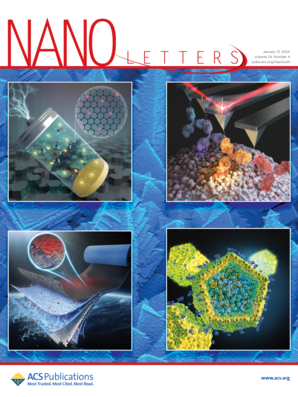Jellyfish-Inspired Ultrastretchable, Adhesive, Self-Healing, and Photoswitchable Fluorescent Ionic Skin Enabled by a Supramolecular Zwitterionic Network
IF 9.6
1区 材料科学
Q1 CHEMISTRY, MULTIDISCIPLINARY
引用次数: 0
Abstract
Ionic hydrogels suit ionic skins, but advanced hydrogels are challenging. Inspired by jellyfish, we developed an ionic hydrogel with ultrastretchability, conductivity, adhesion, self-healing, and photoswitchable fluorescence via a supramolecular zwitterionic network. This hydrogel consists of silk fibroin, zwitterionic betaine analogue, biomineral calcium salts, and spiropyran in a dynamically cross-linked macromolecular network. Calcium ions facilitate electrical signal transmission and ionic interactions, while spiropyran enables photoswitchable color and fluorescence. Density functional theory and Fourier transform infrared analysis reveal abundant hydrogen bonding, ionic associations, and van der Waals forces, contributing to stretchability, adhesion, and self-healing, making them ideal for epidermal electrodes. The hydrogel also shows potential in optical printing and anti-counterfeiting applications due to spiropyran’s reversible photochromic and photoluminescent behaviors. Moreover, a jellyfish-like robot capable of electric-driven movement is created by using these features. This study enhances understanding of dynamic noncovalent interactions in zwitterionic networks, enriching hydrogel design principles and advancing intelligent ionic skins.

由超分子两性离子网络实现的水母启发的超可伸缩、粘接、自修复和光切换荧光离子皮肤
离子水凝胶适合离子皮肤,但先进的水凝胶具有挑战性。受水母的启发,我们开发了一种离子水凝胶,通过超分子两性离子网络,具有超拉伸性、导电性、粘附性、自愈性和光切换荧光性。这种水凝胶由丝素、两性离子甜菜碱类似物、生物矿物钙盐和螺吡喃在一个动态交联的大分子网络中组成。钙离子促进电信号传输和离子相互作用,而螺吡喃使光切换的颜色和荧光。密度泛函数理论和傅里叶变换红外分析揭示了丰富的氢键、离子结合和范德华力,有助于拉伸性、粘附性和自我修复,使其成为表皮电极的理想选择。由于螺吡喃的可逆光致变色和光致发光行为,水凝胶在光学印刷和防伪方面也显示出潜力。此外,利用这些特征,还发明了一种类似水母的机器人,可以通过电力驱动运动。这项研究增强了对两性离子网络中动态非共价相互作用的理解,丰富了水凝胶的设计原理,并推进了智能离子皮肤的发展。
本文章由计算机程序翻译,如有差异,请以英文原文为准。
求助全文
约1分钟内获得全文
求助全文
来源期刊

Nano Letters
工程技术-材料科学:综合
CiteScore
16.80
自引率
2.80%
发文量
1182
审稿时长
1.4 months
期刊介绍:
Nano Letters serves as a dynamic platform for promptly disseminating original results in fundamental, applied, and emerging research across all facets of nanoscience and nanotechnology. A pivotal criterion for inclusion within Nano Letters is the convergence of at least two different areas or disciplines, ensuring a rich interdisciplinary scope. The journal is dedicated to fostering exploration in diverse areas, including:
- Experimental and theoretical findings on physical, chemical, and biological phenomena at the nanoscale
- Synthesis, characterization, and processing of organic, inorganic, polymer, and hybrid nanomaterials through physical, chemical, and biological methodologies
- Modeling and simulation of synthetic, assembly, and interaction processes
- Realization of integrated nanostructures and nano-engineered devices exhibiting advanced performance
- Applications of nanoscale materials in living and environmental systems
Nano Letters is committed to advancing and showcasing groundbreaking research that intersects various domains, fostering innovation and collaboration in the ever-evolving field of nanoscience and nanotechnology.
 求助内容:
求助内容: 应助结果提醒方式:
应助结果提醒方式:


